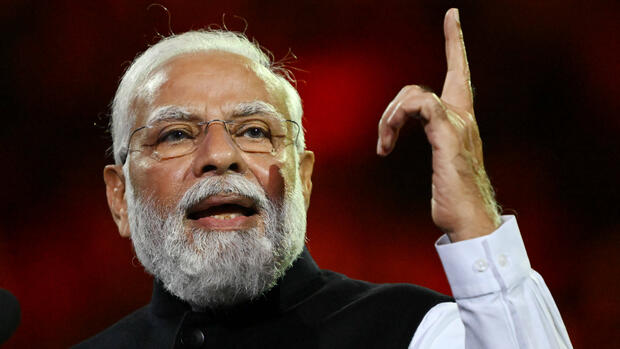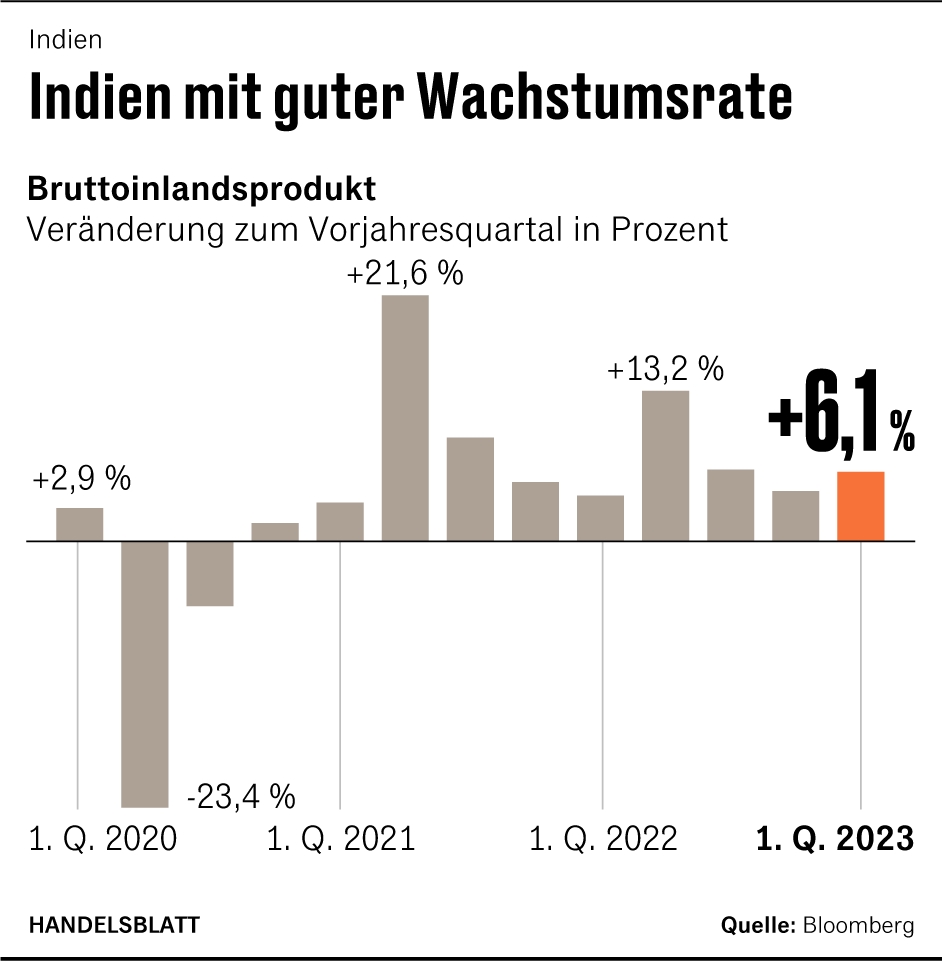Bangkok Indian Prime Minister Narendra Modi has two reasons to celebrate: while he is celebrating his nine-year anniversary with a lavish campaign, his country is storming back to the top of the world economy. In the first three months of the year, the country in South Asia with a population of 1.4 billion experienced a surprisingly significant upswing.
Economic output increased by 6.1 percent compared to the previous year, as the statistics authority in the capital New Delhi announced on Wednesday. Analysts had expected a significantly lower increase of around five percent.
In Indonesia, second in the ranking, gross domestic product (GDP) grew 5 percent in the first quarter. China achieved an increase of 4.5 percent. With the unexpectedly good development in the first three months of the year, India is also putting its most recent slump in growth behind it – in the last quarter of 2022, GDP growth had fallen to around four and a half percent.
The growth rate for the full fiscal year that ended in March is now also better than expected at 7.2 percent. The government had previously forecast 7.0 percent.
Boost for the country and the election campaign
For Prime Minister Modi, who suffered a rare defeat with his party a few weeks ago in regional elections in the economically important state of Karnataka, the strong upswing is of great political importance: He wants to run for a third term in a year – and is trying to boost India’s boom to present as the result of his policy.
As a foretaste of the campaign, he launched a month-long celebration this week to mark the anniversary of his inauguration. Since then, India has made unprecedented progress, according to a statement from his party, which is calling for more than 50 major rallies in the coming weeks. At the start, Modi announced via Twitter: “We will work even harder to build a developed India.”
According to economists, the strong growth at the beginning of the year shows that the prospects for increasing prosperity in Asia’s third-largest economy are well founded: “The GDP data confirm the recent growth optimism, despite the global headwinds,” commented Sakshi Gupta, economist at the Indian HDFC bank .
India’s goods exports have been falling for several months amid falling global demand. However, this is contrasted by rapidly growing IT service and outsourcing businesses: In the past fiscal year, they caused service exports to increase by 27 percent – to more than 320 billion US dollars.
>>Read here: The hyped India as a land of unlimited difficulties
In April, too, they were more than a quarter higher than in the previous year. At the same time, massive investments in infrastructure are helping to keep India on course for growth. The construction industry grew by more than ten percent in the first three months of the year. Capital formation, which statisticians use as an indicator of investments, rose by 8.9 percent.
growth instead of inflation
India’s central bank is optimistic that the trend will continue. In its annual report presented on Tuesday, it mentioned, among other things, lower commodity prices, the increasingly robust financial sector and declining inflation as signs of sustained growth momentum. She also sees “new growth opportunities resulting from the global realignment of supply chains”.
As of this year, India is the world’s most populous country and sees itself in a good position to compete with neighboring China as the world’s workbench. The government in New Delhi hopes to be able to attract industrial companies that want to become more independent of the People’s Republic in the face of increasing political tensions between the West and China. Economists think this is promising.
As of this year, India has more inhabitants than China, making it the most populous country in the world.
(Photo: AP)
The World Economy’s Chief Economists Survey, released in early May, sees South Asia as the main beneficiary of supply chain relocation, with nearly three-quarters of respondents expecting a positive impact on the region, where India is by far the largest economy.
The US electronics group Apple is one of the pioneers of the latest reorientation in Asia: While the company had its iPhones manufactured almost exclusively in China in the past, the proportion of devices manufactured in India is growing steadily: In the past fiscal year, which ended in March , it was almost seven percent, as the financial service Bloomberg reported, citing insiders.
>>Read here: Apple suppliers create almost 50,000 jobs in India
Apple also sees India as an increasingly important sales market. A few weeks ago, the group opened its first sales outlets in the metropolises of Mumbai and Delhi. “There are a lot of people moving up into the middle class,” Apple CEO Tim Cook said of business opportunities in the country. “I have a feeling that India is at a turning point.”
Worry about monsoons and El Niño
However, HDFC economist Gupta also points to risks: There is concern that the monsoon rains, which are important for agriculture, could be weaker than usual this year – as a result of the El Niño weather phenomenon, which is expected this year. According to Gupta, the dangers of a global recession could also have a negative impact on India.
As a result of the El Niño weather phenomenon, the important monsoon rains could be weaker than usual.
(Photo: IMAGO/ZUMA Wire)
It is already apparent that not everyone in India is benefiting from the upswing. Young people in particular still find it difficult to find a job. The unemployment rate rose to 8.1 percent in April, according to the Center for Monitoring Indian Economy, mainly as large numbers of people poured into the labor market.
According to estimates, India needs growth rates of at least seven percent in order to create enough jobs for the rapidly growing population. In order to reach this mark again, the central bank warns: “It is important to continue the structural reforms in order to improve the medium-term growth potential.”
More: India’s rise: why the country can now only jeopardize its own success

